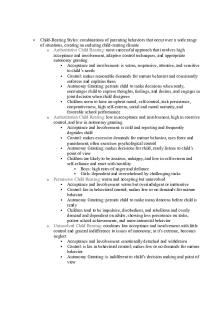Excel Chapter 8 Summary PDF

| Title | Excel Chapter 8 Summary |
|---|---|
| Author | Lia Vee |
| Course | Introduction To Business Information Systems |
| Institution | Southwestern College |
| Pages | 3 |
| File Size | 120.6 KB |
| File Type | |
| Total Downloads | 56 |
| Total Views | 159 |
Summary
SIMNET Excel...
Description
Excel - Chapter 8 - Exploring Data Analysis and Business Intelligence
ChapterSummary 8.1Createandmanagescenariosforworksheetdata(p.E8496). Ascenarioisasavedsetofvaluesinaworkbook. Ascenarioisawhatifanalysistoolbecauseitallowsyoutodisplayandcompare multipledatapossibilitiesinaworksheet. TheScenarioManagercommandisavailablefromtheWhatifAnalysisbuttonin theForecastgroupintheDatatab. IntheAddScenariodialogbox,younameeachscenarioandselectcellstobe changed. IntheScenarioValuesdialogbox,youacceptortypenewvaluesforeachscenario. Onlyonescenariocanbedisplayedintheworksheetatatime. FromtheScenarioManagerdialogbox,youcancreateascenariosummaryreport thatlistsdetailsaboutchangingcellsandresultcellsforallscenariosinaworkbook. 8.2UseGoalSeektobacksolveacellvalueforaformula(p.E8498). Backsolvingisaproblemsolvingmethodthatstartswiththeresultandcalculates thevaluetoreachthatresult. TheGoalSeekcommandtestsvaluesforonecellinaformula. GoalSeekdetermineswhatvalueshouldbeinthecellsothattheformularesultsin aspecifiedvalue. TheGoalSeekcommandisanoptionontheWhatifAnalysisbuttonintheForecast groupintheDatatab. 8.3UseSolvertofindasolutionforaformula(p.E8500). TheSolveraddinisananalysistoolthatsolvesaprobleminreverse. Solverdeterminesthehighest,thelowest,oraspecificresultforaformulaby adjustingvaluesincellsusedintheformula. ASolverproblemhasthreecomponentsknownasparameters,identifiedinthe SolverParametersdialogbox. Theobjectivecellisacellwithaformulathatwillbesolvedforspecificresults.Itis alsocalledthetargetcell. Variablecells,alsoknownasdecisionorchangingcells,arecellsthatSolvercan adjusttoreachtheobjective. Constraintsarerestrictionsorlimitationsonvariablecells,theformula,orother worksheetcellsthatarerelatedtotheobjectivecell. TheSolverResultsdialogboxincludesoptionstokeepthesolution,toreturntothe originalvalues,andtosavetheresultsasascenario. TheSolverResultsdialogboxhasaReportssectionwithanalysisreportsthatcanbe generatedforeachsolution. SolverisactivatedfromtheAddInsdialogboxintheExcelOptionsdialogbox. TheSolverbuttondisplaysintheAnalyzegroupontheDatatab.
8.4Builddatatableswithoneandtwovariables(p.E8508). Adatatableisarangeofcellsinaworksheetthatshowsmultipleresultsforoneor moreformulas. AdatatableiscreatedfromtheWhatIfAnalysisbuttonintheForecastgrouponthe Datatab. Aonevariabledatatablesubstitutesvaluesforoneargumentinoneormore formulas. Atwovariabledatatablesubstitutesvaluesfortwoargumentsinasingle formula. Thevaluesthataresubstitutedareknownasinputvalues. Inputvaluescanbeinaroworacolumn,andtheformulamustbeenteredina specificlocationbasedonwhetherthetableusesoneortwovariables. Inthedatatablerange,theformulacanbetypedorenteredasareferencetothe formulaintheworksheet. IntheDataTabledialogbox,youspecifyaroworcolumninputcellforaone variabletableandbothforatwovariabletable. Theroworcolumninputisthecelladdressintheformulathatisreplacedwithinput values. ADataTablecommandinsertstheTABLEfunctioninanarrayformulaineachresult cell. 8.5Createaforecastsheetfortimebaseddata(p.E8511). Aforecastsheetisageneratedworksheetthatusesexistingdatatoanalyzeand predictresults. Aforecastsheetincludesatableandarelatedchart. Twodataseriesarerequiredtobuildaforecastsheet;oneseriesmustbeadateor timefield. Thedateortimefieldmustusearecognizabletimeinterval. Theforecastchartcanbealineoracolumnchart. TheForecastSheetbuttonisintheForecastgroupontheDatatab. 8.6Getandtransformdatainaquery(p.E8515). Aquerystoresinstructionsforgettingdatafromanexternalsourcefordisplayina worksheet. Aquerycangetdatafromonlineandinhousesourcesincludingdatabaseortext files,XMLdata,andothers. Aqueryestablishesadataconnectiontothesourcesothatthedatacanbe refreshed. DataiscleanedorpreparedintheQueryEditorbeforeitisloadedintoExcel. QueryresultsaredisplayedinanExceltable. Queriesarenamedandsavedwiththeworkbook. Whenacommonfieldexistsintwoormorequeries,thosequeriescanbeusedto createaPivotTable. TheNewQuerybuttonisintheGet&TransformgroupontheDatatab. 8.7ExplorePivotTabletools(p.E8522). AslicerisavisualfilterforaPivotTable,asmallwindowthatfloatsonthesheet. YoucaninsertaslicerforanyfieldinthedatasourceforthePivotTable. AtimelineisavisualfilterforadatefieldinaPivotTable.
TheInsertSlicerandInsertTimelinebuttonsareintheFiltergrouponthe PivotTableToolsAnalyzetab. Slicersandtimelinesareobjectsthatcanbepositioned,sized,andformatted. TheValueFieldSettingsforafieldinaPivotTabledeterminehowvaluesare summarized. Youcanchangethecalculationusedforvaluefields,showcustomcalculations,or insertacalculatedfield. Acustomcalculationisabuiltinpercentage,ranking,orratio. AcalculatedfieldisafieldthatisnotinthedatasourceforaPivotTableandisbuilt fromaformulawithoneofthefieldsinthesourcedata. InsertacalculatedfieldfromtheFields,Items,&Setsbutton[PivotTableTools Analyzetab,Calculationsgroup]. PivotTablefieldscanbeformattedfromtheValueFieldSettingsdialogboxorfrom theNumbergroupontheHometab. LayoutoptionsforaPivotTableincludehowandwheretotalsdisplayandthereport format. TheGETPIVOTDATAfunctiondisplaysresultsfromaparticularcellinaPivotTable. ForexpandedPivotTablefunctionsandcommands,thePowerPivotaddincanaccess millionsofrecordsforanalysisinareport. 8.8UsetheAnalysisToolPaktocalculatestatisticalmeasures(p.E8529). TheAnalysisToolPakisanExceladdinwithbuiltinstatisticalandengineering calculations. Aftertheaddinisinstalled,theDataAnalysisbuttonappearsintheAnalyzegroup ontheDatatab. TheDescriptiveStatisticscommandcalculatesandgeneratesalistofpopular measuresforadatarange. TheMovingAveragecommandcalculatesandgeneratesalistofrunningorrolling averagesforasetofvalueswitharelatedchart. OtherAnalysisToolPakcommandsincludecovariance,regressionanalysis,and randomnumbergeneration.
CheckforUnderstanding The SIMbook for this text (within your SIMnet account) provides the following resources for conceptreview: Multiplechoicequestions Matchingexercises Shortanswerquestions...
Similar Free PDFs

Excel Chapter 8 Summary
- 3 Pages

Chapter 8 - Persuasion (Summary)
- 6 Pages

Excel Module 8 LKE
- 18 Pages

Excel Semana 8
- 3 Pages

D 3-8 - summary of chapter 8
- 5 Pages

Chapter 8 Study Guide - Summary
- 8 Pages

Chapter 8 - Summary World Art
- 3 Pages

Bio 101 Chapter 8 summary
- 2 Pages

COMM 20 Chapter 8 Summary
- 2 Pages

5- Summaries chapter 8-Summary
- 3 Pages
Popular Institutions
- Tinajero National High School - Annex
- Politeknik Caltex Riau
- Yokohama City University
- SGT University
- University of Al-Qadisiyah
- Divine Word College of Vigan
- Techniek College Rotterdam
- Universidade de Santiago
- Universiti Teknologi MARA Cawangan Johor Kampus Pasir Gudang
- Poltekkes Kemenkes Yogyakarta
- Baguio City National High School
- Colegio san marcos
- preparatoria uno
- Centro de Bachillerato Tecnológico Industrial y de Servicios No. 107
- Dalian Maritime University
- Quang Trung Secondary School
- Colegio Tecnológico en Informática
- Corporación Regional de Educación Superior
- Grupo CEDVA
- Dar Al Uloom University
- Centro de Estudios Preuniversitarios de la Universidad Nacional de Ingeniería
- 上智大学
- Aakash International School, Nuna Majara
- San Felipe Neri Catholic School
- Kang Chiao International School - New Taipei City
- Misamis Occidental National High School
- Institución Educativa Escuela Normal Juan Ladrilleros
- Kolehiyo ng Pantukan
- Batanes State College
- Instituto Continental
- Sekolah Menengah Kejuruan Kesehatan Kaltara (Tarakan)
- Colegio de La Inmaculada Concepcion - Cebu





